4.4 Sending Calendar Items
4.4.1 Understanding Calendar Items
You can schedule appointments and reminder notes for yourself and other users. You can also reserve a block of time by using a posted appointment.
For information about how appointments and reminder notes differ from other item types, see Section 1.9, Understanding GroupWise Item Types.
If you want to find out if someone is coming to your meeting, you can check for an accepted or declined status in the item’s Properties. For more information, see Working with Sent Items.
All scheduled items can be retracted or rescheduled, even if the recipients have already opened and accepted them. For more information, see Section 3.2.3, Retracting Sent Email and Section 3.2.5, Editing Sent Appointments, Tasks, and Reminder Notes.
For more information about managing items after they have been sent or received, see Section 3.1, Sending Email and Section 3.3, Receiving Email.
4.4.2 Scheduling Appointments
Use appointments to schedule blocks of time on a specific date or range of dates.
You can use Busy Search to check for a time when all the users and resources you want for an appointment are available.
When you perform a Busy Search for users who are in a different time zone than you, GroupWise takes into consideration the difference in time zones. For example, if you are trying to schedule a meeting with a co-worker whose time zone is seven hours later than your own, that co-worker’s workday is blocked out in the Busy Search sometime after 10:00 a.m. your time.
When you schedule an appointment and include yourself as a participant, GroupWise automatically accepts the appointment for you unless there is a conflicting appointment, in which case you will receive a notification stating you have a conflicting appointment. This occurs when you try to send the appointment.
Scheduling an Appointment for Yourself
If you are not available for meetings, you can schedule a posted appointment for those times. When another user includes you in an appointment and does a busy search, the user can see that you are not available at those times, but can still schedule over your appointment.
Posted appointments are placed in your Calendar on the date you specify. They are not placed in your Mailbox or in any other user’s Mailbox. Similarly, all posted appointments are saved to your main GroupWise calendar. To move them to a personal calendar, drag and drop them to the personal calendar after they are created.
-
On the toolbar, click the arrow on the
 button, then click .
button, then click .
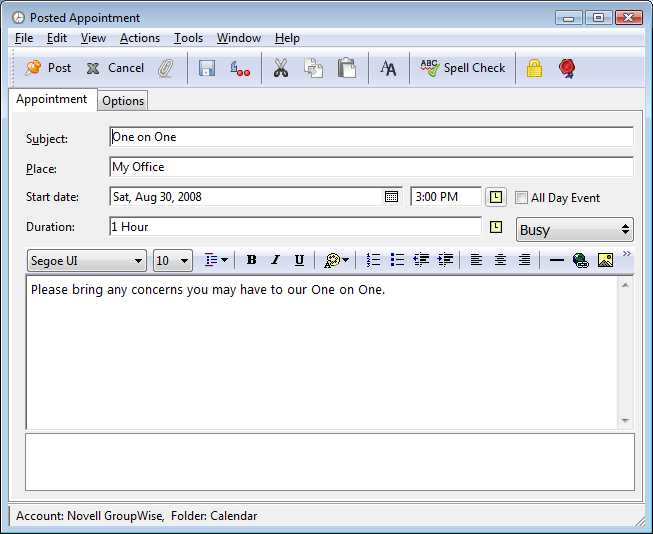
or
In your Calendar, open a view with an Appointments List, click a date, then double-click a time in that day.
-
(Optional) Type a subject and a place.
-
Specify the start date.
or
Click
 to specify a date or auto-date for your appointment. To create a recurring appointment, see Section 4.4.4, Scheduling Recurring Items.
to specify a date or auto-date for your appointment. To create a recurring appointment, see Section 4.4.4, Scheduling Recurring Items.
or
Select for an all day event.
For more information about all day events, see Understanding All Day Events.
-
Specify a start time and duration. Duration can be in minutes, hours, or days.
-
Specify how you want the appointment to appear with the drop-down menu. Appointments can appear as , , , or .
-
(Optional) Type a message.
You can specify many options, such as making this appointment a high priority and more, by clicking the tab.
-
(Optional) Specify a Show Appointment As type by clicking > , then clicking a type.
-
Click on the toolbar.
Scheduling an Appointment for Multiple People
-
Click
 on the toolbar.
on the toolbar.
-
In the field, type a user name, then press Enter. Repeat for additional users. Include any resource IDs (such as conference rooms) in the field. If necessary, type user names in the and fields.
or
To select user names or resources from a list, click on the toolbar, double-click each user, then click .
Your name is automatically added to the field of the appointment. When you send the appointment, it is automatically added to your calendar. If you do not want to be included in the message, delete your name from the field.
-
To change the From name (to another account or proxy), click
 , then click a name.
, then click a name.
-
(Conditional) If a place hasn’t been added as a resource on the field, type the place description in the field.
-
Specify the start date.
or
Click
 to specify a date or auto-date for your appointment. To create a recurring appointment, see Section 4.4.4, Scheduling Recurring Items.
to specify a date or auto-date for your appointment. To create a recurring appointment, see Section 4.4.4, Scheduling Recurring Items.
or
Select for an all day event.
For more information about all day events, see Understanding All Day Events.
-
Specify a start time and duration. Duration can be in minutes, hours, or days.
-
Specify how you want the appointment to appear as. Appointments can appear as , , , or .
Recipients in the and fields receive the appointment as Free.
-
Type a subject and message.
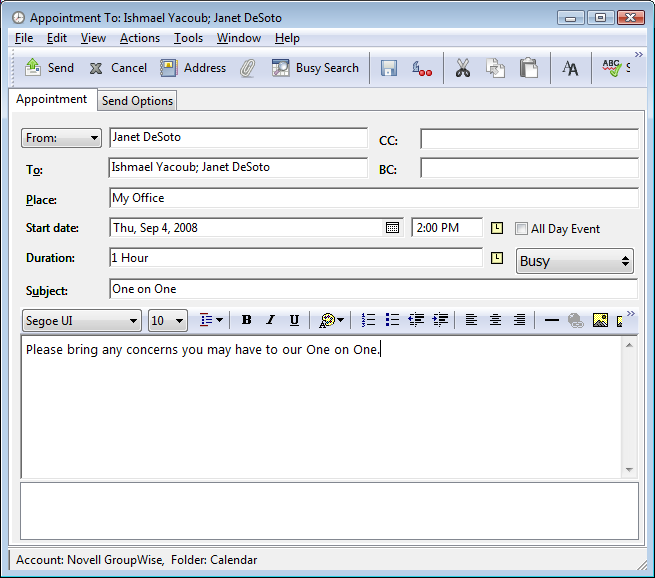
-
If you want to make sure the people and resources for the appointment are available, do a busy search by clicking on the toolbar. For more information, see Using Busy Search to Check Availability.
You can specify many options, such as making this appointment a high priority, requesting a reply from recipients, and more, by clicking the tab.
-
Click on the toolbar.
If the appointment conflicts with an appointment that is already on your calendar, you are given the option to continue scheduling the appointment or to change the appointment.
Using Busy Search to Check Availability
Use Busy Search to find a time when all the people and resources you want to schedule for a meeting are available.
Performing a Busy Search
-
In an appointment you are creating, specify user names and resource IDs in the field.
-
Specify the first possible day for the meeting in the field.
-
Specify the meeting’s duration.
-
Click on the toolbar.
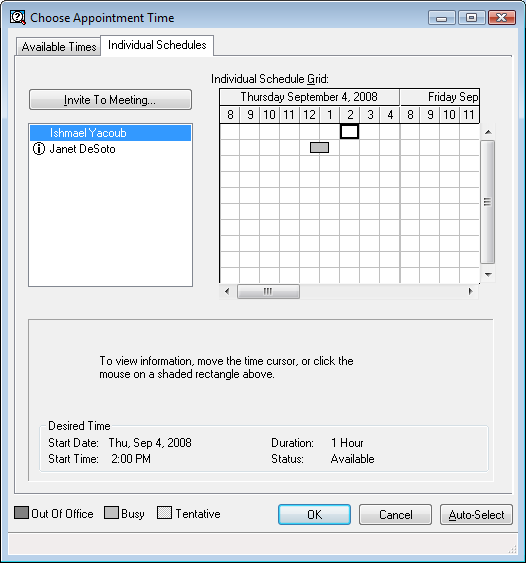
The legend at the bottom of the Busy Search dialog box shows the meaning of the various Show Appointment As patterns on the grid.
If
 appears to the left of the user name or resource, you can click a scheduled time across from the user name or resource on the tab to display more information about the appointment in the box below. However, the user or resource owner must give you appointment Read rights in their Access List before the
appears to the left of the user name or resource, you can click a scheduled time across from the user name or resource on the tab to display more information about the appointment in the box below. However, the user or resource owner must give you appointment Read rights in their Access List before the  icon appears. See Granting Proxy Rights as a Mailbox Owner.
icon appears. See Granting Proxy Rights as a Mailbox Owner.
To exclude a user name or resource from the search without deleting it, click the tab, then click the check box next to the user or resource to deselect it. Excluding a person or resource from the search is useful if a user (like a CC recipient) should be invited to a meeting but does not necessarily need to attend. To include a user or resource name that has been excluded, click the check box next to the user or resource to select it.
-
Click to select the first available meeting time, then click to transfer the users, resources, and selected time and duration to the appointment you were scheduling.
or
Click until the time you want is displayed, then click to transfer the users, resources, and selected time and duration to the appointment you were scheduling.
or
Click the tab to see possible meeting times, click a time to select it, then click to transfer the users, resources, and selected time and duration back to the appointment you were scheduling.
-
To remove a user or resource from the list after the search, click the tab, click the user name or resource to remove, press , then click .
This is useful if you want to include several conference rooms in the search to find one that is available, then eliminate those you do not want.
-
Complete and send the appointment.
If you want to do a busy search before creating an appointment, click > . Specify information in the Busy Search dialog box, then click to perform a busy search. When you find a time you want for a meeting, click to transfer the information to a new appointment view, then complete the appointment.
You can change the search range for one appointment by scheduling the appointment with > and changing the number in the .
This method is useful when you are scheduling recurring appointments or planning appointments with users and you want to see the users’ schedules further into the future than the default seven days.
Changing Busy Search Options
You can change the search range, time, and days default for all appointments on the tab in Date Time Options.
-
Click > , double-click , then click the tab.
-
Change the options you want.
Options include the range of dates or specific days to search.
-
Click .
Understanding All Day Events
When you are creating a GroupWise appointment, you can choose to make the appointment an all day event by selecting , located next to the time input field.
You can specify how you want the appointment to appear by clicking the availability button, located below the select box. Appointments can appear as , , , or . Unlike regular appointments, all recipients receive all day event appointments as Free by default. This is because all day events are often intended to be strictly informational for recipients. For example, you might send out an all day event to inform colleagues that you are going to be on vacation. In this case, colleagues who receive the event are not shown as Busy on the day of the event.
Changing How All-Day Events Are Displayed
You can change the way that all day events are accepted into your calendar by using the Options menu.
-
Click > , double-click , then click the tab.
-
In the area, click the drop-down menu located beneath , then choose the option you want.
-
Click .
When you send an All-Day Event to recipients, the time appears as by default. The sender can choose to have the event show as in recipients’ calendars, but must do so each time they send an All-Day Event.
Time Input
When you schedule appointments and other items you might be required to specify a time. In most cases you have the option to specify the time by typing it directly into the time field or entering it through the time input field. Click  to open the time input window.
to open the time input window.
Figure 4-8 Time Input Window
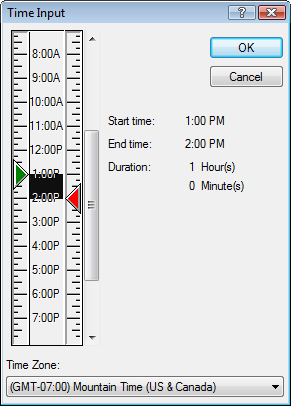
Use the green arrow to select a start time and the red arrow to select an end time. The currently selected times display on the right side of the screen. You can use intervals as small as 15 minutes.
If a correct duration has already been entered, you can move it by dragging the selected area up or down.
A time zone option is available to specify a specific time zone for the event. For more information on time zones, see Specifying a Time Zone for an Appointment.
Specifying a Time Zone for an Appointment
The Time Zone feature lets you schedule a meeting for recipients in different time zones who will meet in a single location.
Normally, GroupWise automatically adjusts meeting times based on the recipients’ time zones. For example, a meeting scheduled by a user in Utah for 10:00 would be displayed as 9:00 for a recipient in California and as 12:00 for a user in New York because these users are in different time zones. Because GroupWise adjusts the time, all the users scheduled for a conference call can call in at the same moment, even though their local time might differ.
Use the Time Zone feature if you don’t want GroupWise to adjust to the recipients’ local time zone. For example, if you are in the Saskatchewan time zone and include users from the Mountain Time (US & Canada) time zone in your appointment, you would use the Time Zone feature if these users are flying to Saskatchewan for the appointment. Time Zone ensures that the appointment in their Calendars and Mailboxes shows the correct Saskatchewan time.
-
Open and create a new appointment.
-
Click > , click the drop-down list and select the time zone for the appointment location, then click .
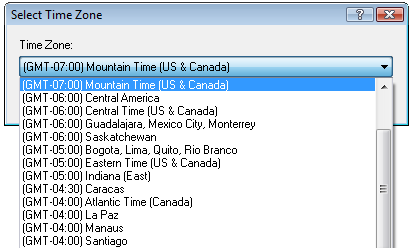
-
Click on the toolbar.
When the users you have scheduled with the Time Zone feature receive the appointment, they see a time annotation after the subject when they see the appointment in their Mailboxes. For example, if the subject of the meeting is “Marketing Conference” and the time zone is Saskatchewan, users would see a subject and time annotation similar to the following: Marketing Conference (Saskatchewan). In the users’ Calendars, the place is annotated with the time zone, rather than the subject.
Canceling an Appointment
You can cancel an appointment if you scheduled it or if you have the necessary Proxy rights to the scheduler’s Mailbox.
-
In your calendar, right-click the appointment you want to cancel, then click .
-
Select to remove it from other users’ mailboxes. Leave this option deselected if you want to delete it only from your own mailbox.
-
(Optional) Type a message explaining the cancellation.
-
Then click .
A Meeting Cancelled message is sent to each user that the appointment was sent to, and the appointment is removed from the user’s calendar. Users who had the appointment delegated to them do not receive a Meeting Cancelled message, but the appointment is removed from their calendars.
Canceling a Recurring Appointment
You can cancel a recurring appointment if you scheduled it or if you have the necessary Proxy rights to the scheduler’s Mailbox.
-
In your calendar, right-click the recurring appointment you want to cancel, then click .
-
Select .
-
(Optional) Type a message explaining the cancellation.
-
Click .
-
Click , , or .
A Meeting Cancelled message is sent to each user that the appointment was sent to, and the appointment is removed from the user’s calendar. Users who had the appointment delegated to them do not receive a Meeting Cancelled message, but the appointment is removed from their calendar.
Modifying an Appointment
When an appointment is modified, changes simply appear on recipients’ appointments with no message appearing in users’ mailboxes. The modified appointment is displayed as bold and a notification banner is displayed inside the appointment, indicating to users which sections of the appointment have been modified. Users are not prompted to re-accept the appointment.
For information on how to modify an appointment and other email items, see Section 3.2.5, Editing Sent Appointments, Tasks, and Reminder Notes.
To reschedule an appointment for a new time on the same day:
-
Open your Calendar and drag the appointment to the new time.
Copying an Appointment
Like with other types of email items, you can copy an existing appointment to create a new appointment. For more information, see Section 3.2.6, Duplicating Sent Email.
4.4.3 Sending Reminder Notes
Reminder notes are like mail messages except they are scheduled for a particular day and appear on the Calendar for that date. You can use reminder notes to show vacations, holidays, paydays, birthdays, and so forth.
Scheduling a Reminder Note for Yourself
A reminder note to yourself is called a posted reminder note. Posted reminder notes are placed in your Calendar on the date you specify. They are not placed in your Mailbox or in any other user’s Mailbox.
-
From your Calendar, open a view with a Reminder Notes List (for example, the Week view).
-
Click a date, then double-click an empty space in the Reminder Notes List.
-
If necessary, click
 to specify a start date or auto-date for your reminder note.
to specify a start date or auto-date for your reminder note.
-
Type a subject and the reminder note message.
You can specify many options, such as making this reminder note a high priority and more, by clicking the tab.
-
Click on the toolbar.
To access the information later, open your Calendar and select the date the information appears on. Double-click the reminder note in the Reminder Notes List.
Scheduling a Reminder Note for Others
-
Click > > .
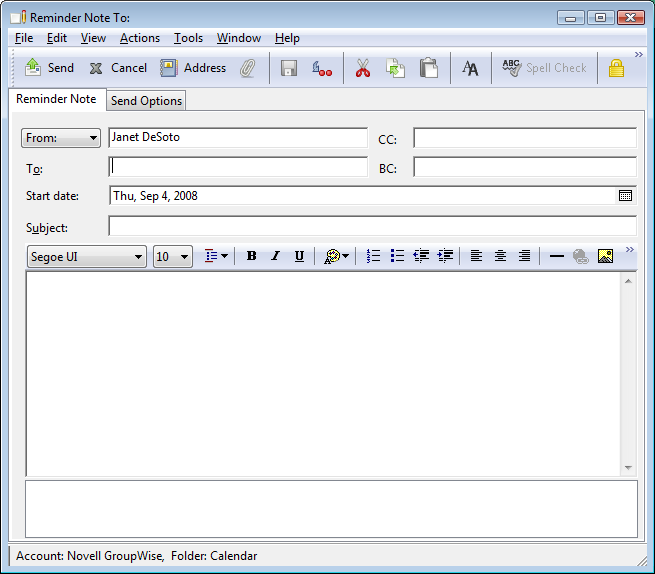
-
In the field, type a user name, then press Enter. Repeat for additional users. If necessary, type user names in the and fields.
or
To select user names from a list, click on the toolbar, double-click each user, then click .
-
To change the From name (to another account or proxy), click
 , then click a name.
, then click a name.
-
(Optional) Type a subject and the reminder note message.
-
In the field, type the date this reminder note should appear in the recipients’ Calendars.
or
Click
 to specify a start date or auto-date for your reminder note.
to specify a start date or auto-date for your reminder note.
You can specify many options, such as making this reminder note a high priority, requesting a reply from recipients, and more, by clicking the tab.
-
Click on the toolbar.
4.4.4 Scheduling Recurring Items
You can send appointments, tasks, and reminder notes as recurring items. Recurring items can be scheduled daily, weekly, monthly, yearly, or according to custom settings that you define.
When you send a recurring item, GroupWise copies the item and places one of the defined dates in each copy of the item. For example, if you define five dates for the event, GroupWise makes five copies of the item and schedules one copy for each date. If you send the item to other users, you have five outgoing items with five occurrences. If you receive the event, you find five copies of the incoming item in your Mailbox, each scheduled for a different date.
Scheduling a Daily Recurring Item
-
In an appointment, task, or reminder note you are scheduling, click , then click .
-
Select the pattern of recurrence, start date, end date (or number of occurrences), then click .
Scheduling a Weekly Recurring Item
-
In an appointment, task, or reminder note you are scheduling, click , then click .
-
Select the pattern of recurrence, start date, end date (or number of occurrences), then click .
Scheduling a Monthly Recurring Item
-
In an appointment, task, or reminder note you are scheduling, click , then click .
-
Select the pattern of recurrence, start date, end date (or number of occurrences), then click .
Scheduling a Yearly Recurring Item
-
In an appointment, task, or reminder note you are scheduling, click , then click .
-
Select the pattern of recurrence, start date, end date (or number of occurrences), then click .
Scheduling a Custom Recurring Item by Dates
This type of custom recurrence allows you to select specific days from a year calendar.
-
In an appointment, task, or reminder note you are scheduling, click , then click .
-
On the tab, click the days you want to schedule.
-
To move to a different year, click the year button, type the new year, then click .
-
If you want to clear all the dates you have selected, click .
-
Click .